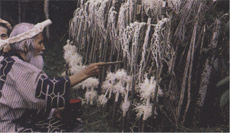Hokkaido Toyako Summit
Venues

In addition to elements of Shinto-based culture dating back to ancient times, such as Matsumae Kagura, Hokkaido is home to a long list of folk art and festivals brought by migrants from Honshu, and of the culture that has been preserved and handed down by the Ainu people.
The Ainu people consider that spirits reside in all natural phenomena, animals and plants, as well as in the tools people make. According to the Ainu people's beliefs, these spirits change their forms and come down to Earth from the Heavens entrusted with their missions.
A Kamuinomi, or prayer to the gods is a ceremony to pay homage to the things necessary for people's lives or to phenomena beyond human power as gods, or to pray for the stability of people's lives, or to offer appreciation to the gods for their protection up until now.

in the Jomon Period
This clay figure, discovered among Jomon Period remains in Hakodate City, became the first artifact from Hokkaido to be designated as a National Treasure in June 2007.
http://www.dokyoi.pref.hokkaido.lg.jp/hk/bns/doguu.htm (Japanese Only)
Also, Hokkaido is proceeding with its efforts to register its Jomon remains and large-scale vertical shafts that are designated as national historical relic sites on the World Heritage List.